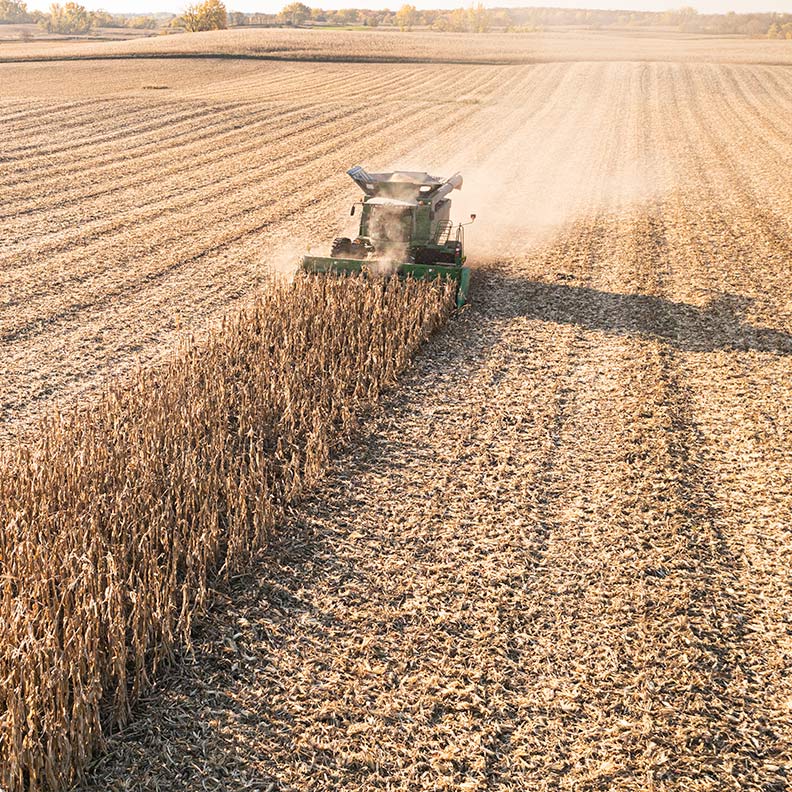A bullish commodity market has significantly helped agriculture producers throughout summer and into harvest. Corn is up 26.3%, wheat up 25.9%, and soybeans up 21.7% since early August. U.S. harvest has been progressing well with strong yields being reported throughout the Corn Belt. On top of favorable prices and yields, USDA rolled out additional COVID support via the Coronavirus Food Assistance Program 2 (CFAP 2).
U.S. row crop
Harvest throughout the U.S. is well ahead of the five-year historical average with 83% of soybeans, 72% of corn, and 89% of sugarbeets already out of the field, according to USDA. Winter wheat planting is tracking on average with 85% of the crop in the ground.
A plethora of bullish factors have been fueling the current commodity price rally, including strong exports; strong global demand for crops, protein and dairy goods; suspect weather around the world in key crop growing regions; and increased speculation positions by investors.
USDA began accepting applications for CFAP 2 on September 21 and as of October 25, over $7.6 billion has been paid to U.S. farmers, with over half paid to crop farmers. We encourage all agriculture producers to inquire about CFAP 2 eligibility with their local FSA Office.
U.S. livestock and dairy
Livestock farmers may see an increase in prices by the end of 2020 due to processors catching up on the backlog of animals, according to Purdue University. Delays in herd expansions throughout COVID-19 will slowly decrease the domestic supply of hogs and other livestock.
Livestock and dairy producers have been actively signing up for the second USDA coronavirus assistance program, CFAP 2. About 10% of payments thus far have been paid to dairies and 28% to livestock. For dairy, the payment calculation is simply $1.20 per cwt based on production and livestock is a fixed price per head of inventory.
Ground-level insights from ag bankers
Dan Duthie, Greater WI
Overall, this year’s weather and crop has been very good. Soybean harvest is getting close to finishing up with about 90% complete and averaging 52 to 62 bushels per acre (bpa). Some isolated dry spots dipped down to 40 to 50 bpa. This year’s wheat harvest, what little there was, turned out to be disappointing with yields below the 70 bpa mark. Hay yields were well above average with many producers averaging 1.5 to 3.0-ton dry matter to the acre better than in 2019 and well above five-year averages. Corn silage was some of the best that farmers can remember with yields being 5.0 to 8.0 ton better than 2019 and 4.0 ton better than average. Gross yields averaged between 21 and 38 tons per acre in the eastern third of the state. I have not talked to anybody that has averaged less than 200 bpa in corn and some field averages were around 265 bpa.
I see two main things that producers are using CFAP funds for. The farmers that have struggled over the last four to five years used these funds to pay down debt and payables. The farmers that were in good shape over the last few years used these funds to make needed updates to equipment that has been put on hold due to the tight margins.
The livestock producers are very happy about the government payments, but there is worry about the risk of another shutdown in the slaughter plants with COVID numbers on the rise. Milk demand is strong right now and the dairy processors will take all the milk you can send them, but are requesting that farms hold off on expanding herds. I spoke to a few dairies that were thinking of expanding, but in both cases passed with even their builders saying now is not the right time with year-over-year building estimates up 40%.
Bryce Gorder, Southwest MN
We have been very fortunate with local weather this growing season and harvest time. Timely June and July rains made for an excellent corn crop, yielding well above average in most areas. With that being said, the southwest Minnesota region missed out on August rainfall, which was crucial for our soybean production. Furthermore, growers north of the Marshall area experienced heavy winds during the growing season, which had a yield-robbing effect on corn as well as making harvest more difficult due to goose necking and green snap. Harvest appears to be wrapping up in our region with above average yields on corn and near average yields on soybeans.
CFAP and CFAP 2 payments have helped producers weather the impacts that the pandemic caused. Growers will predominantly use the funds to compensate for losses incurred on 2019 crop sales, in addition to any potential market disruptions going forward with 2020 sales. Top reasons of concern continue to be market uncertainty with COVID and the upcoming election, while top reasons for optimism include the recent rallies in commodity prices due to an uptick in Chinese purchases as well as slow planting progress in South America. Considering where we were back in April, we are now much more bullish about the future.
Robert Lipetzky, Northeast ND
For the most part, weather was good for the season, although there was some prevent plant, especially to the west of Grafton. Soil moisture was quite low until this last batch of snow and we didn’t have any real measurable moisture for the last 6-7 weeks. The dryness was great for harvest, besides causing dirt lumps in potatoes and making it difficult to get beet lifters in the ground. We are about 85% harvested, with only a few sunflower and corn fields left. Corn dried down fast this year. I’m getting yield reports that are variable, but near average. Areas that had moisture did very well and others that ran out of moisture were below average. There was a fair amount of 30-ton beet yields.
We’ve had 2-3 tough years in this area and I think most operations will use CFAP funds to recoup working capital and improve their balance sheets. In livestock, one of the main concerns, besides getting a better price for market animals, was feed. It was tough to get the hay most producers were used to last year and that lead to some commercial cow sales. Even if they were proactive and planted some feed, be it silage or hay on tillable ground, they got burnt a bit because of the weather and trying to get it put up and out of the fields. This year, most producers had a good feed crop. One thing I’ve notice is breeding stock – bred heifers, open heifers, cows, pairs, bulls, etc. are still commanding decent prices. Most cow calf growers already tightened up on expenses and understand that they will need to sell some inventory and grow feed to remain profitable.
Global ag
China’s hog herd is starting to rebuild after African Swine Fever swept through and killed millions of hogs and erased upwards of 60% of the breeding stock, according to Reuters. The herd expanded 9% from June 2020 to September 2020. Although U.S. corn and soybean prices are increasing, the U.S. is very competitive against record high prices in both China and Brazil. China has purchased 71% of its Phase 1 Ag Purchase Target from the U.S. as of October 23, according to the U.S. government, and implemented 50 of the 57 commitments.
Brazil will officially eliminate their 8% import tariff on corn through March 31, 2021, and soybeans through January 15, 2021, to help provide relief to high domestic commodity prices and inflation. Farmers in Brazil are slow to plant the 2020/21 soybean crop due to below-average soil moisture levels. Although rains moved into Brazil over the last few days, only 23% of the soybean crop was planted by October 22, according to AgRural, which is approximately two weeks behind schedule. Argentina corn planting is also behind due to dry conditions.
A La Niña weather patten will likely persist throughout the U.S. winter, which typically causes a drier growing season for South America and in the U.S., dry conditions in the South, cool conditions in the western Corn Belt and wet conditions in the eastern Corn Belt. Throughout winter, this is a concern to U.S. winter wheat production. Dry conditions are also forecasted for the winter wheat regions east of the Black Sea, according to Reuters.
What to watch for
A few major events are coming quickly including the U.S. Presidential Election on November 3 and the ongoing bullish sentiments for crop prices due to U.S. export demand. There is a rare situation of strong export demand, an early snow season for the Upper Midwest, and relatively high yields throughout the U.S. The next weather-related trigger will likely be a change to either the dryness in South America or U.S. weather during the tail end of harvest. If Brazil’s planting continues to get delayed, thus leading to a late harvest, it may position U.S. crops to help meet buyer demand on the global market in March 2021.



